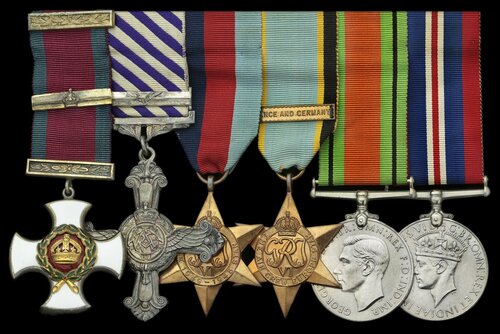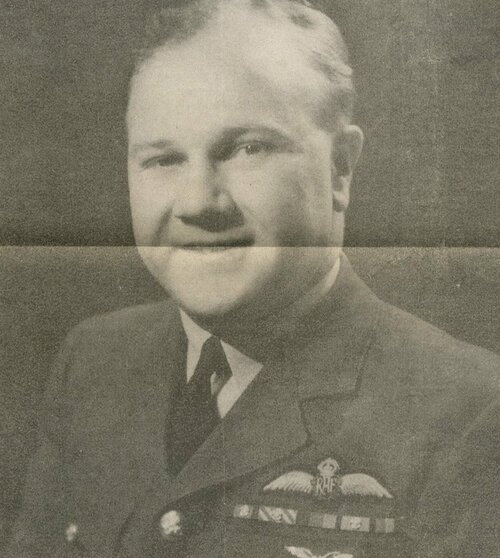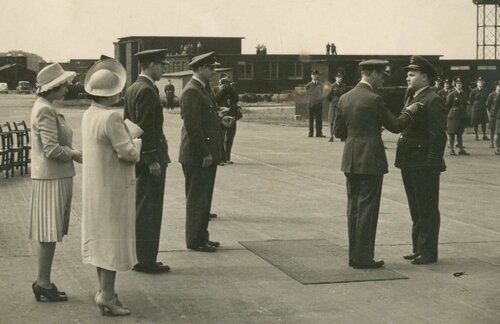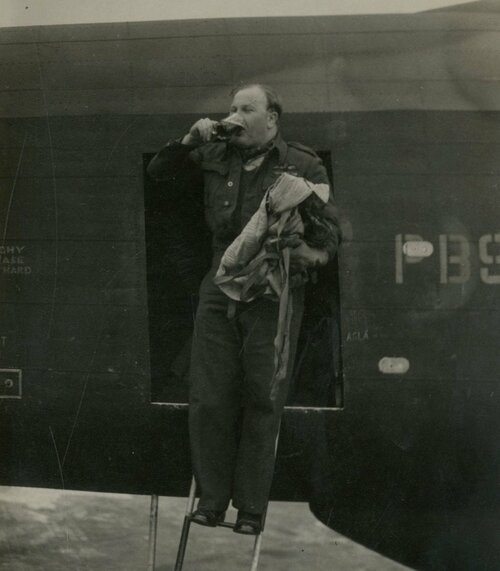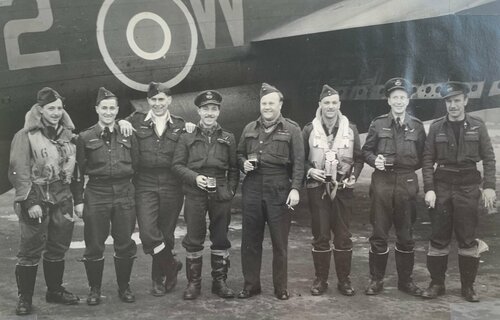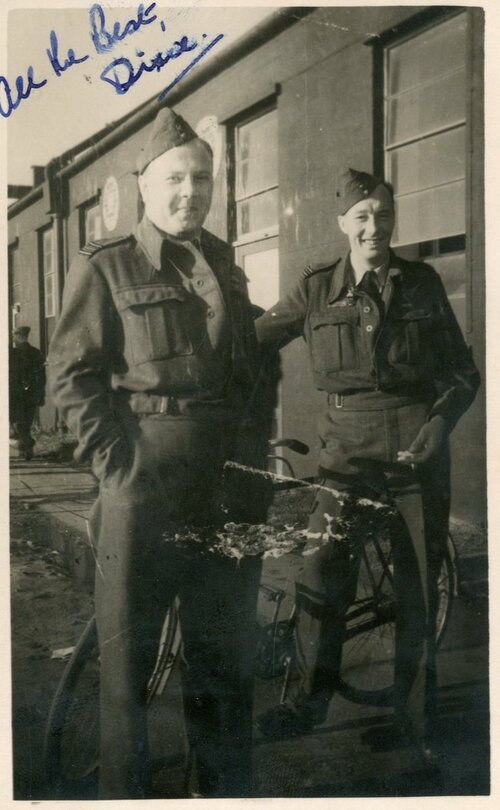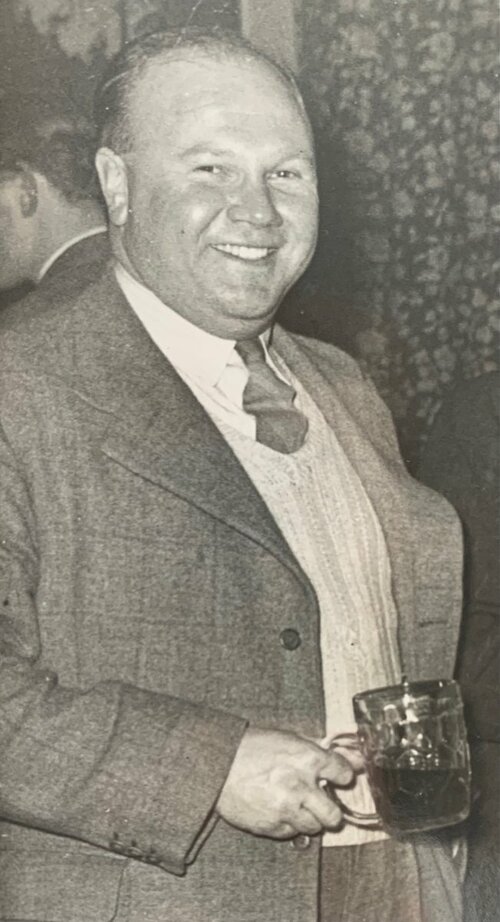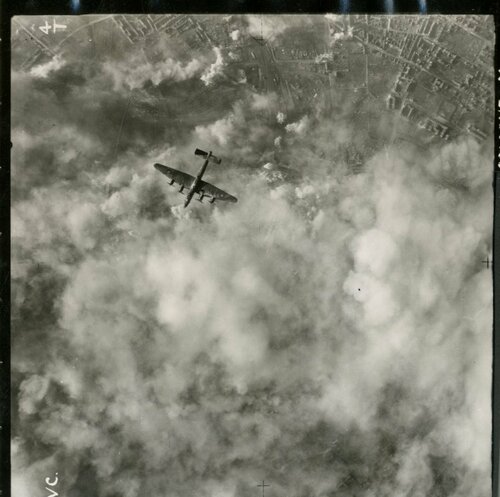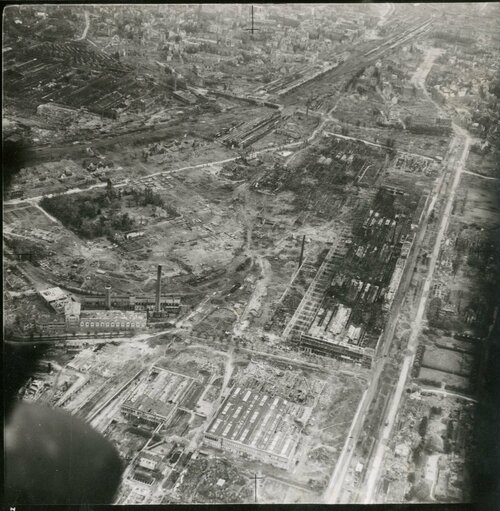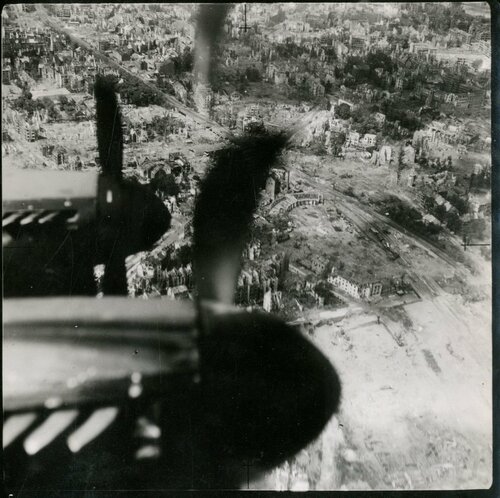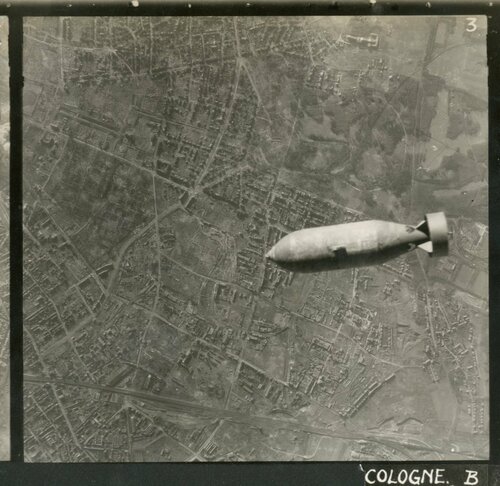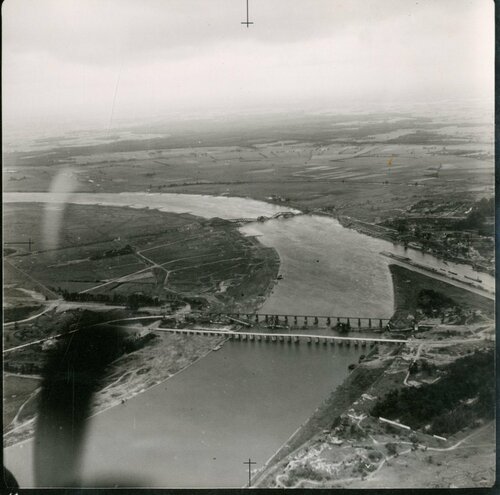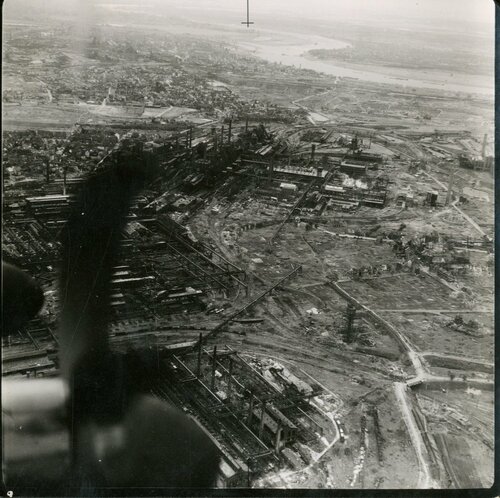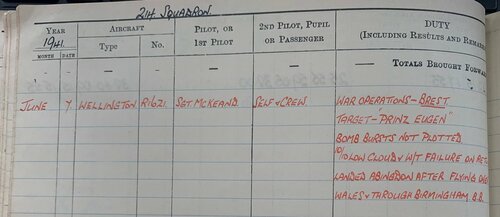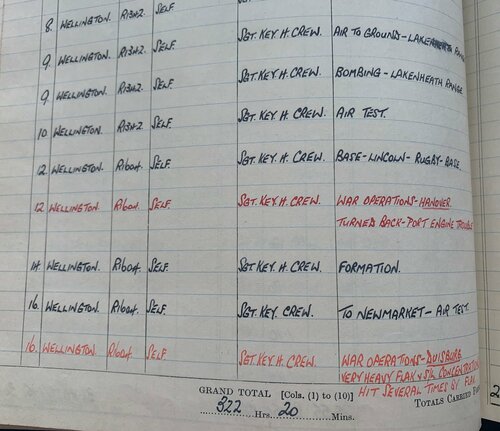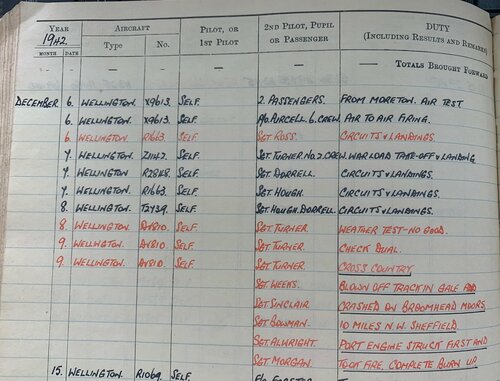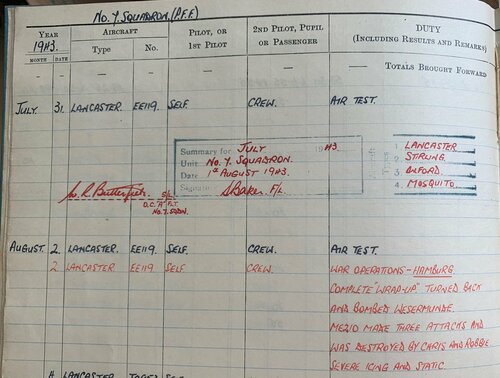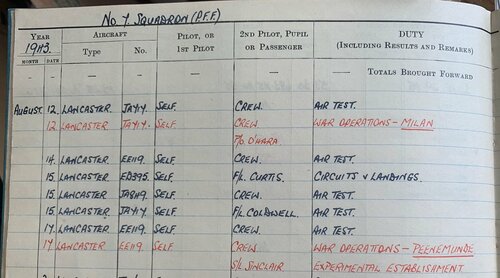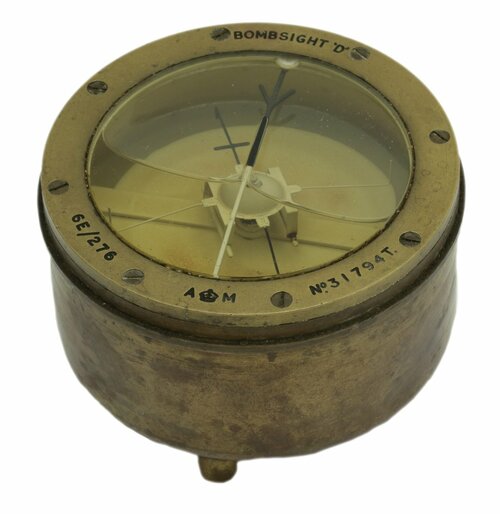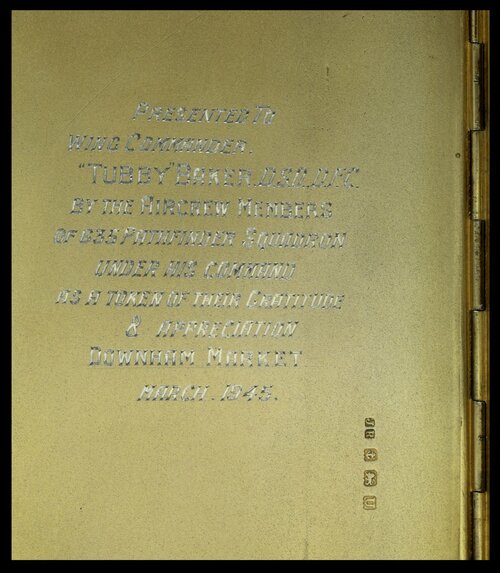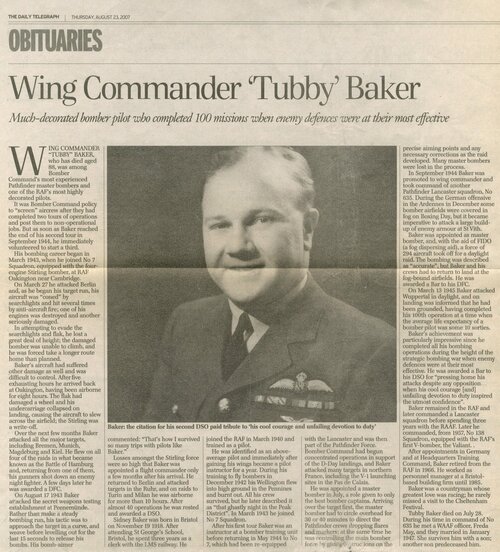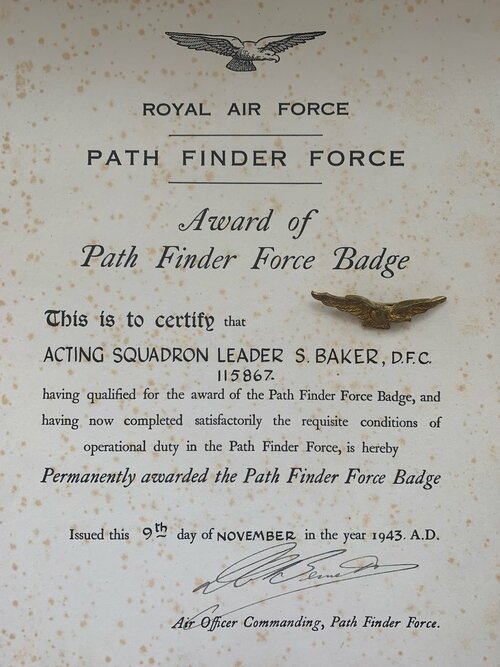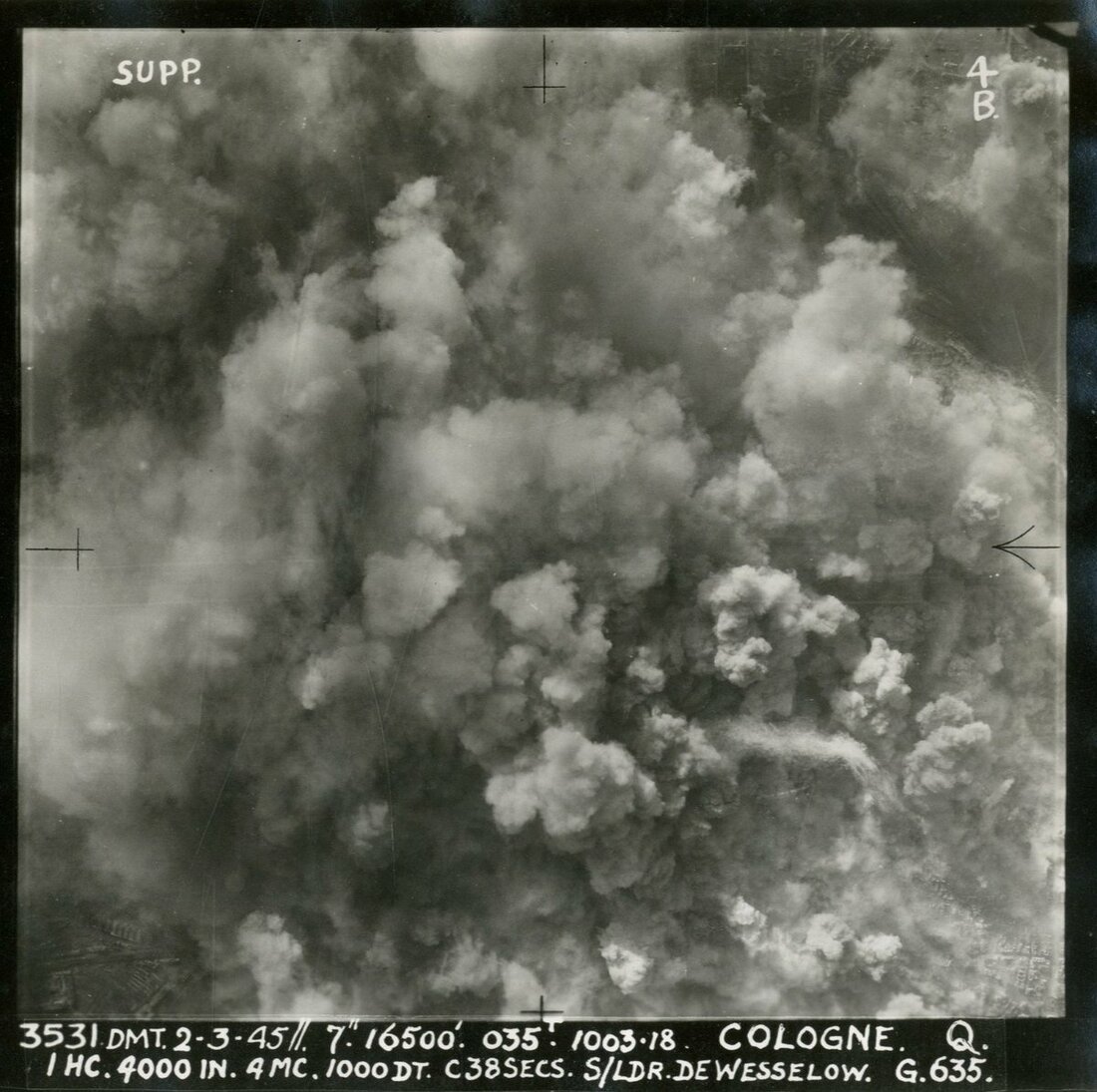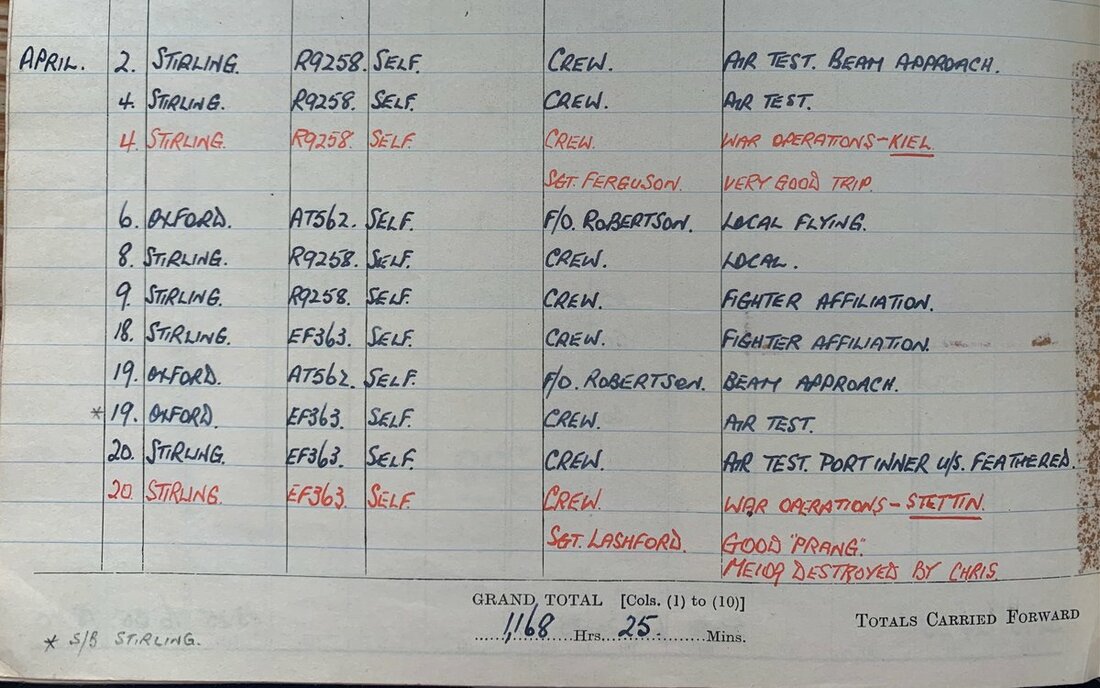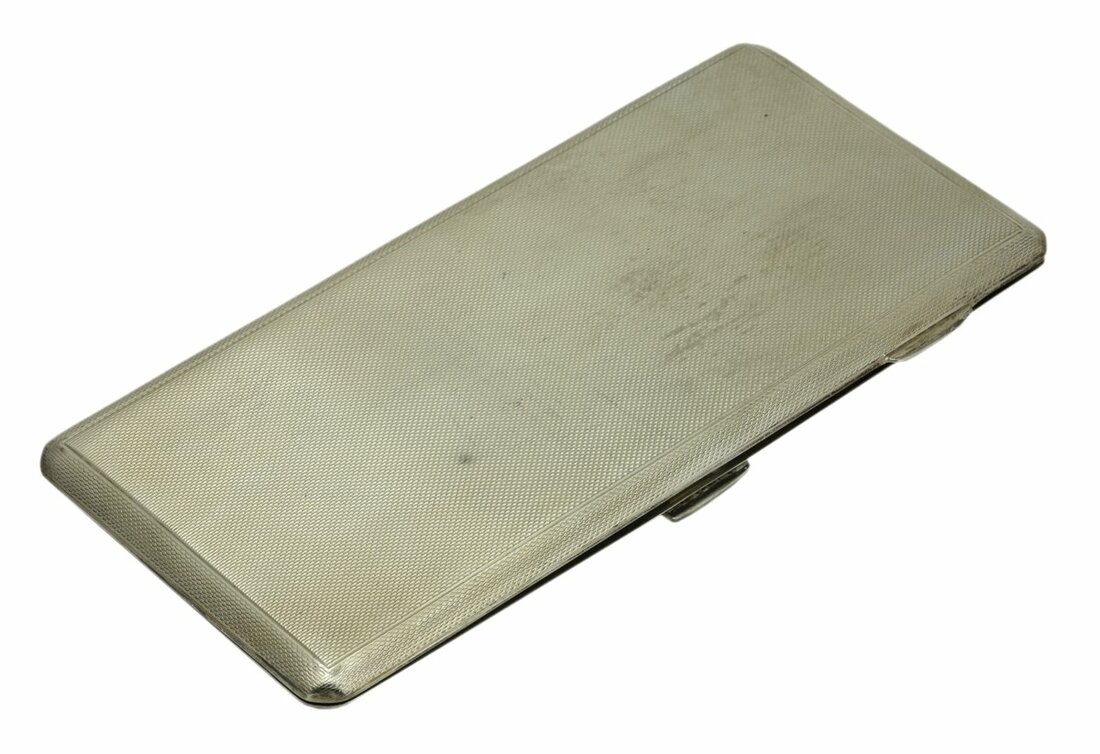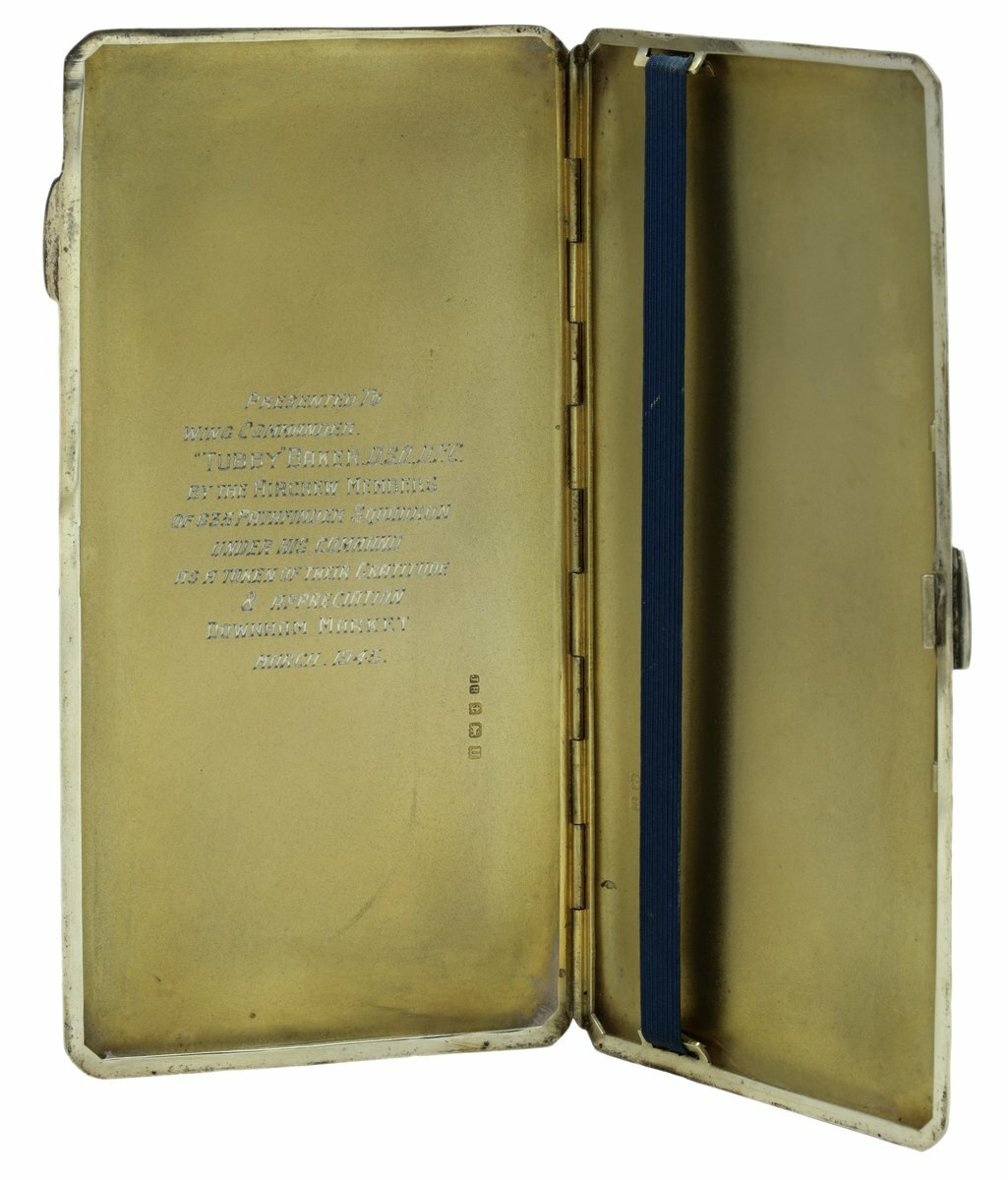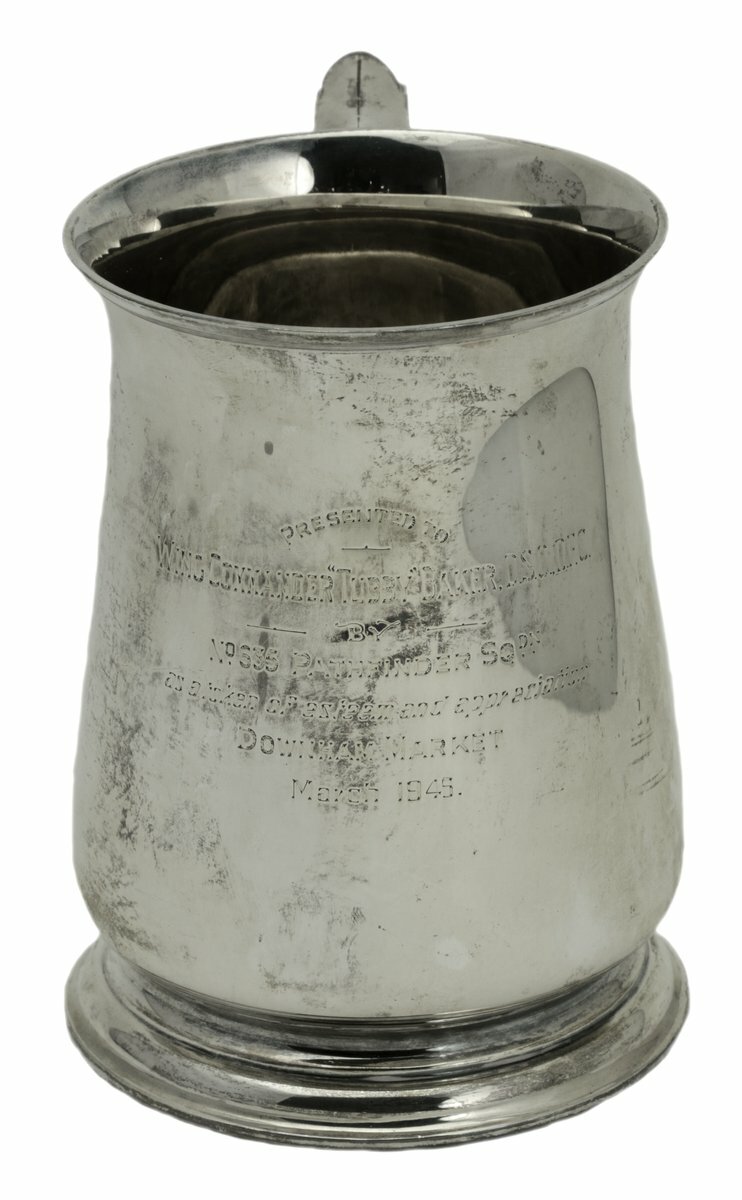Auction: 21002 - Orders, Decorations and Medals
Lot: 247
The remarkable and important 'Bomber Command' Second World War 'Immediate' 1944 D.S.O. and 1945 'Immediate' Bar, 1943 D.F.C. and 1944 Bar group of six awarded to Wing Commander S. 'Tubby' Baker, Royal Air Force, one of the finest and most highly-decorated Airmen of the Path Finder Force
A distinguished member of an elite club - which totals just a handful of members - of Airmen to notch up 100 Operational Sorties during the Second World War, Baker did all of his 'century' against the most heavily defended targets in Europe in heavy bombers; further still some 20 of them were completed as Master Bomber
Baker cut his teeth in the Wellingtons of No. 214 Squadron, before moving onto Stirlings and Lancasters of No. 7 Squadron, which saw him fly on the Peenemunde Raid in August 1943; over the course of his remarkable four tours, he took command of No. 635 Squadron in September 1944 shortly after the death of Squadron Leader I. Bazalgette, V.C.
Baker flew on important targets in North-West Europe following the Normandy Landings, perhaps none less so than when leading a force of some 300 Lancasters as Master Bomber on St Vith on Boxing Day 1944, when they smashed a vast armoured concentration of the 6th SS Panzer Division
He was finally 'grounded' and presented a Bar to his D.S.O. to go with a pint of beer after his 100th Op in early 1945 - the latter was photographed going down in one; his unique record of service marks him out amongst the finest to have flown with Bomber Command and the Path Finder Force during the Second World War, whilst it should be noted the citation for that last award is striking in its similarity to that of Wing Commander Leonard Cheshire's Victoria Cross
Distinguished Service Order, G.VI.R., the reverse officially dated '1944', with Second Award Bar, the reverse officially dated '1945', with its Garrard & Co. case of issue; Distinguished Flying Cross, G.VI.R., the reverse officially dated '1943', with Second Award Bar, the reverse officially dated '1944'; 1939-45 Star; Air Crew Europe Star, clasp, France and Germany; Defence and War Medals 1939-45, mounted as worn, good very fine (6)
Provenance:
Purchased directly from the recipient's family and offered on the open market for the first occasion.
D.S.O. London Gazette 7 January 1944. The original recommendation states:
'This officer has been one of the most reliable and conscientious Captains in this squadron. His ability and devotion to duty have at all times been highly commendable. He has taken part in all the recent raids against some of the most heavily defended targets in Germany and Italy. This officer's leadership and co-operation have been of the utmost value to the Squadron and an outstanding example to junior crew. His services as Flight Commander have been most satisfactory.'
Bar to D.S.O. London Gazette 1 May 1945. The original recommendation states:
'On 13 March 1945, this officer, as Captain of aircraft, carried out the duties of Master Bomber, and controlled a heavy raid on the important industrial centre of Wuppertal in the Ruhr.
Weather conditions were such that in order to carry out his duties correctly, it was necessary for this officer to fly at a very low height in order to assess the bombing, and give aiming instructions to the large force of aircraft. He accepted this risk unflinchingly, and disregarding all defences for over 20 minutes made a series of bombing runs and carried out his duties admirably, with the result that the raid was very successful.
Wing Commander Baker has now completed 100 Sorties as Captain on heavy bombers, all of which have been against the most heavily defended targets in the European theatre of war. He has, in his capacity as Master Bomber, successfully controlled 20 major raids against heavily defended targets, and throughout his whole operational career has shown unflinching courage and determination to press home his attacks. Since September 1944, as Commanding Officer of a heavy bomber Squadron, he has at all times set a high personal example which has had a very marked effect on the operational efficiency of his Squadron. No matter what the odds, this officer has always given of his best, and by keeping a very cheerful outlook he has been instrumental in instilling good morale and confidence into his junior officers and aircrew. On many occasions he has personally attacked targets on three engines, and his efforts are deserving of the highest praise.'
D.F.C. London Gazette 13 August 1943. The original recommendation states:
'Flying Officer Baker has carried out 40 Operational Sorties, of which nine have been with the Path Finder Force. He is a most capable Captain of aircraft with many successful sorties to his credit, and has, on several occasions, demonstrated a cool courage in pressing home his attacks against heavily defended targets. He has raised the efficiency of his crew to a high level by conscientious attention to detail and has set a fine example to the Squadron.'
Bar to D.F.C. London Gazette 8 December 1944. The original recommendation states:
'Wing Commander Baker, a Captain of aircraft and Flight Commander, has completed 82 operational sorties (437 flying hours), 22 of them since his previous award. He is on his third operational tour and has operated many times as Master Bomber against some of the most heavily defended targets. His outstanding ability has always inspired the utmost confidence of his crew. Since the award of the Distinguished Service Order, he has continued to display fine fighting spirit, cool courage and a firm determination to press home his attacks, despite any opposition, which are worthy of high praise.'
Sidney Baker - or 'Tubby' to his friends and comrades - was born at Clapton-in-Gordano, Somerset on 19 November 1918, being educated at St. George's School, Bristol. He held the Somerset Scholarship and was a prize winning miler, prior to joining the L.M.S. Railway.
Living at The Glen, Abbot's Leigh, Baker was examined under the Military Training Act on 19 July 1939 and entered the Royal Air Force Volunteer Reserve on 30 March 1940.
First tour
Baker flew his first solo on a DH82 on 4 September 1940 and having earned his 'Wings', joined No. 214 Squadron, a Wellington unit operating out of Stradishall, Suffok. Completing his first sortie with them on 4 May - against Brest - he flew another 29 trips between then and the end of his first tour that October, including no less than seven strikes against Cologne, three against Bremen and Mannheim, and a brace against Berlin. His 5th Op - an attack on Brest had set their course to attack the Prince Eugen. They faced 10/10 cloud and were forced to land at Abingdon after flying over Wales and through Birmingham with the added issue of W/T failure. His 19th Op would also see Baker's kite take several hits from accurate flak over Duisburg. It would not be the last time.
His first tour was completed with his 29th Op to Bremen on the night of 21 October. Baker was not far from the action and actually set off on another raid on Kiel on 23 October, but they suffered electrical failures and he did not add them to his tally.
Not much of a rest
Duly "rested" as an instructor, he was nonetheless called upon to participate in a raid on Dusseldorf on 10 September 1942, and was lucky to survive an encounter with high ground in the Pennines on 9 December - his aircraft was burnt out but all of his crew survived what he later described as 'that ghastly night in the Peak District.' As he recalled, after having come down to 1,200ft having been blown badly off course in high winds, assuming he was over the North Sea:
'Almost immediately there was a bang and my port engine was on fire…I throttled back both engines and began to hold off. Reaching up I opened my escape hatch and from the light of the blazing port engine, belly landed. I ordered the crew out and scrambled clear myself.'
DV810 erupted in a huge fireball. Having stayed with the wreck overnight, they were eventually rescued and taken to Stocksbridge. The crew went off to hospital, but Baker was suffering shock - besides a large gash to his head - and was given a bed at the local Police Sergeant's cottage. He was glad of the bed but felt terrible he had shed so much 'claret' onto the bed linen of the wife of his host. He clearly made a good impression, however, for she sent cakes to 'Tubby' for months to come.
Upon his return, he faced an order to report to the OC Moreton, who opened with:
'Baker! What do you mean by crashing one of my bloody aircraft?'
Fixing the OC with his gaze, he gave both barrels in reply:
'What do YOU mean by sending me off in such bloody awful weather?'
Let us put this one down as a score draw.
Second tour - Pathfinder
In early March 1943, he returned to an operational footing with No. 7 Squadron, but this time in a Pathfinder role. Another 30 sorties ensued, mainly of the heavily-defended German variety, and including a hair-raising trip to Berlin on 27 March when his Stirling was "coned" by searchlights and hit several times by flak, one engine being destroyed and another seriously damaged. Having then lost a great deal of height in his successful attempt to break away from both lights and flak, he nursed his crippled aircraft back to Oakington where, on landing, the damaged undercarriage collapsed, causing the bomber to slew across the airfield.
Another moment of high drama followed in a trip to Stettin on the night of 20 April, an incident recounted in Gordon Musgrove's Pathfinder Force:
'Flying Officer S. Baker was 20 miles north of Stettin when the Mid-Upper Gunner, Flight Sergeant C. Thornhill, saw an Me. 109 going in the opposite direction. The fighter pilot spotted the Stirling, made a steep turn, put the Messerschmitt in a shallow dive to gain speed and made his attack from underneath and astern. The Rear Gunner, Flight Sergeant J. E. Robbins, followed the manoeuvre closely and warned Baker to be ready to dive to port. Before the enemy was set Robbins opened fire and shouted "Go, go, go" to his pilot. The Messerschmitt broke away and climbed giving Robbins a second chance; he raked the fighter with a long burst setting it on fire. Both gunners and the Wireless Operator saw it hit the ground still burning.'
Baker noted in his Log Book:
'Good "Prang". Me109 destroyed by Chris.'
They also had a run-in with the strong enemy defences over Bochum on his 36th Op on 13 May when they were coned and holed in his No. 5 port tank and the starboard pitot head. Nonetheless, he adjudged it a 'very successful raid'.
Baker qualified for his Path Finder Force Badge on 15 June 1943. He was finally recommended for a long overdue D.F.C. on 30 June 1943, shortly before the Squadron converted to Lancasters, Baker went on to participate in all of the famous "firestorm" raids on Hamburg between 24 July and 2 August, an offensive largely made possible by the successful use of Window - he would later describe how the confused flak and searchlight defences were 'all over the place' as a result (see Martin Middlebrook's Battle of Hamburg). But from Baker's perspective, the Hamburg "firestorm" raids were memorable for another reason - namely a further closely fought engagement with a nightfighter on 2 August. Gordon Musgrove's Pathfinder Force once more takes up the story:
'On the night of August 2-3, to add to the bombers' problems, the nightfighters were up in numbers in spite of the appalling weather. Baker, now a Flight Lieutenant, was over Westermunde when Thornhill, his Mid-Upper Gunner, reported an exhaust glow 400 feet below and 350 feet astern on the starboard side. Thornhill fired a short burst and ordered a dive to starboard while Robbins, although he could not see anything to shoot at, fired along the Mid-Upper's tracer. When the fighter broke away to port above it was identified as an Me. 210. A second attack was made from the starboard and both gunners observed strikes on the enemy. Baker then made for cloud but as he came out of it the fighter was waiting and the German, not realising the quality of the opposition, had the temerity to close to 200 yards. Both gunners again scored hits; the enemy suddenly stopped firing and dived away to starboard. A red ball of fire was seen in the cloud below and seconds later a red explosion. Lancaster G-George, although showing a few scars on the tailplane caused by cannon fire, proudly boasted another bomb painted on the side to mark the completion of another sortie, but this bomb was adorned with a small swastika to signify an enemy fighter had been destroyed.'
Then on the night of 17 August, Baker participated in the famous Peenemunde raid, his 49th Op, on this occasion piloting Lancaster EE-119, an outing later recalled by his Bomb Aimer, Flight Lieutenant Peter Cutchey (see Martin Middlebrook's Peenemunde Raid):
'We arrived early and banked out to sea, to the east of Pennemunde, to waste the unwanted time with the maximum safety. From there, I had a wonderful view of the whole area and could pick out the general area of our Aiming Point, though not the individual buildings. I watched the smoke-screen start up but that didn't do them any good as far as I was concerned. We came back in on a very hairy, weaving bombing run. Why were we weaving? Tubby Baker always moved the aircraft around quite a lot but he always steadied down for the last bit. He used to say that I was the finest Bomb Aimer for hitting the target after a curved approach.
That's how I survived 73 trips with chaps like Tubby Baker. People who went straight in and level, with long bombing runs, just didn't survive. But Tubby always levelled out for those last fifteen seconds. As we came in, Tubby headed towards the already positioned red Target Indicators but I directed him further north. As we came in to where I judged our Aiming Point should be, I could see groups of buildings by now and then I picked up the sports field which was on my target map and I knew I was on the right target. I aimed my markers to the left of that sports field. It wasn't so much the moon that helped me see the Aiming Point but the flares dropped by earlier Pathfinders. A flare spreads its light over a large area. There wasn't a large group of them but there were enough for me to see the ground.'
Baker finally completed his second tour, with his 60th Op, a strike against Kassel on 22 October 1943, was recommended for an immediate D.S.O., and resumed his role as an instructor. The D.S.O. resulted in a probable 'first', that being The King, Queen and Princess Elizabeth all visiting the Squadron for the sole purpose of personally investing Baker with the decoration.
Third tour
In May 1944, however, he commenced his third operational tour back with No. 7 Squadron, again as a Pathfinder and in Lancasters, flying his first mission - against Angers - on the 28th. And between then and mid-August, he completed another 21 sorties, quite a few of them in support of the Normandy landings, or against V-1 sites in the Pas de Calais, but others to Germany - thus a brace of strikes against Stuttgart that July, in which month he was appointed a Master Bomber: as such, he was required to circle the target area for around 20 or 30 minutes, first to direct the Pathfinders' flares and markers, and afterwards the main bomber force. He flew as Master Bomber on the daylight raid on Villers Bocages on 30 July. His tour finished with his 82nd Op to Bremen on 18 August.
Fourth tour
In August 1944, following that raid on Bremen, Baker was recommended for a Bar to his D.F.C., his total number of sorties now having risen to beyond the 80-mark, and in the following month he was appointed to the command of No. 635 Squadron, another Pathfinder Lancaster unit, based at Downham Market, Norfolk. He took a call from Air-Vice Marshall Bennett who let him know he was one of three candidates for the job, having turned down the option of a Mosquito Squadron sometime before. The good news came that afternoon and Baker was told to get to Downham Market as soon as possible. He first checked in at Oakington to clear all the paperwork required for his move, only to get a call from Bennett at 10am the next morning. He gave Baker a fine introduction:
'AOC here Tubby. I thought I told you to be at Downham Market this morning. Have you ever heard of bull---- and red tape in this group?'
Baker duly dropped his papers and jumped in an aeroplane and made it a flying entrance to his command of No. 635 Squadron.
Once more acting as Master Bomber in many of his remaining 18 sorties - the first of them was flown on 20 September, against Calais, and the last, against Wuppertal, on the 13 March 1945. He came to the Squadron at a pivotal point, for it had just lost Squadron Leader Ian Bazalgette, who had won his superb posthumous Victoria Cross whilst Master Bomber for the raid on the V-rocket sites at Trosy-St Maxim on 4 August 1944. The risks for those in that position were clear to all and it would not have escaped the mind of Baker. It was his duty to lead the way.
A case in point was Baker's leadership of a vital daylight strike against enemy armour at St Vith during the Battle of the Bulge on Boxing Day 1944. As well as a railway, roads to Vielsalm, Laroche, Recht and Houffalize passed through St Vith and made it the most important road junction on the Sixth SS Panzer Army front. Intelligence came in that a large force had been building, which it was understood had the potential to break through at a critical time in the Battle.
Enter the redoubtable Baker from stage left to fly his 91st Op. He was the man of the moment, but as a result of heavy fog, his 294-strong force had to take-off, and land, with the aid of FIDO (the fog dispersal aid).
At 1500hrs, with Baker at the head as Master Bomber, the force rounded on St Vith and dropped 1,138 tons of high explosive. Huge craters in the roads made all routes impassable. German Sappers, who worked on the St Vith-Malmedy road, stated that it was beyond repair. On the following day, St Vith was placed out of bounds to both troops and civilians, and all military traffic used was forced to use secondary roads as bypass routes.
The following is noted by Project Overlord, The RAF and Campaign to Liberate Northwest Europe:
'Of all the attacks on choke points during the Ardennes battle, this was the most effective. Clearance work did not begin in earnest until 29 December, and the roads through the town were still impassable to traffic on 3 January. More German engineers arrived on the 8th, but they were mainly tasked to keep open the by-pass north of St Vith. Attacks by fighter-bombers constantly interrupted repair work, while long-range American artillery intermittently shelled the area. By 11 January, 16 days after the last air bombardment, all roads running through the town remained blocked. Only the junction of two routes leading to Malmedy and Monschau (located in the northern outskirts) had been opened.'
Record breaker - 100 Club
And so, finally, to his 100th Sortie on 13 March 1945, a daylight mission as Master Bomber flying Lancaster PB914 to Wuppertal, where he made several runs over the target and remained for over 20 minutes - on arriving back at base, he discovered that he was "grounded" with immediate effect.
Baker was duly handed a pint of beer, true to form it went 'down the hatch' in one. He enjoyed a few more glasses with his comrades, with a constant cigarette as a worthy accompaniment.
He had now completed four operational tours amounting to 530 hours flying time and 100 sorties, 20 of them as Master Bomber, a feat made all the more remarkable by virtue of the fact most of his targets had been in Germany at a time when enemy defences were at their most effective - indeed he had visited Berlin and Stuttgart on four occasions, Hamburg and Mannheim on five, and Cologne no less than eight times. He was awarded an immediate Bar to his D.S.O.
This record puts Baker in a truly elite '100 Club'. The other members were:
Wing Commander Leonard Cheshire, V.C., O.M., D.S.O. & Two Bars, D.F.C.
Wing Commander J. B. Tait, D.S.O. & Two Bars, D.F.C.
Squadron Leader P. Granswick, D.S.O., D.F.C. & Bar.
One should compare the career, record and citation of Cheshire's Victoria Cross to that of the epic 100 Ops completed by Baker. It should also be noted that whilst Baker, Cheshire and Tait completed their 100 Ops over the most heavily defended targets in Europe, some 52 of those completed by Granswick were done against in the (perhaps) less heavily defended targets of the Middle East.
His combination of gallantry awards is one of just 27 to Royal Air Force and Commonwealth Air Force Officers in the 1939-45 War, the majority going to Fighter Command.
The record of Baker is unique due to his remarkable record that 20 of his 'century' were completed as Master Bomber, perhaps the most dangerous role of all in Bomber Command. This remarkable wartime record puts Baker in the 'Premier Division' and surely second to only a handful of Bomber Command Aircrew.
Further exploits - Journey's end
Baker remained in the Royal Air Force after the War, spent three years on attachment to the Royal Australian Air Force and commanded, from 1957, No. 138 Squadron, equipped with the R.A.F's first V-bomber, the Valiant. He took his Squadron over to the United States in 1958 for the Strategic Air Command Bombing & Navigation Competition.
Appointments in Germany and Training Command followed until, in 1966, he retired in the rank of Wing Commander.
His love for food, drink and cigarettes led to his unsurprising nickname 'Tubby', which aptly described his larger-than-life character. Described in his obituary in the Daily Telegraph as 'a countryman who greatest love was racing; he rarely missed a visit to the Cheltenham Festival', Baker died in July 2007, aged 88 years.
Sold together with the following complete and comprehensive archive of original material:
(i)
His four Flying Log Books, covering 21 August 1940-2 June 1960, the Wartime entries often accompanied with photographs of his crew.
(ii)
His Air Ministry Lancaster Bombsight 'D', Ref. 6E/276 No.31794T, supposedly a trial object of which just a handful are known to exist outside Museum collections.
(iii)
Two trusty silver presentation items, this being his well-used beer tankard and cigarette case, the first engraved 'Presented to Wing Commander 'Tubby' Baker, D.S.O., D.F.C., No. 635 Pathfinder Sqdn. as a token of esteem and appreciation. Downham Market March 1945', the second with matching dedication but with dedication from the Aircrew of the Squadron, besides another pewter tankard, this engraved 'Wing Commander S. Baker, D.S.O., D.F.C., R.A.F., Valiant XD.858 S.A.C. Bombing Competition 1958.
(iii)
His Path Finder Force Badge, together with its original certificate, dated 9 November 1945, the Air Ministry forwarding letter pasted into his Log Book.
(iv)
A plethora of original papers, including entry Letters and Passes, Inoculation & Vaccination Certificates, his passport, and other related items to his wife, a Section Officer in the Women's Auxiliary Air Force.
(v)
Bestowal document for the Distinguished Service Order, dated 7 January 1944.
(vi)
His notes and written accounts of his career, as used in Pathfinders 635 Squadron, with a copy of the book, signed by the author Chris Coverdale.
(vii)
A large number of photographs of his career and bombing photos, including the occasion of the investiture of his Bar to the D.S.O.
(viii)
Other related items, including his un-opened First Aid Kit, various Squadron cloth Badges, besides copied research and written record of his 100 Ops.
Subject to 20% VAT on Buyer’s Premium. For more information please view Terms and Conditions for Buyers.
Sold for
£70,000
Starting price
£25000

